
current / archive / issues / faq / RSS feed / twitter /
Blog Archive: June 2021
With Foes Like These...Today we're looking at yet another single panel flashback appearance by Doctor Doom, and once again it's all to do with Secret Wars.
When this issue came out it was about 18 months since the last issue of the original "Marvel Superheroes Secret Wars" series, but its importance to the shared Marvel storyworld is clear from the way it keeps on popping up, explaining costume changes, changes to team line-ups and, as here, the introduction of new characters. A big chunk of this story is about the relationship between Titania, who got her powers on Battleworld, and long-time Thor villain The Absorbing Man. We've looked at stories about quite a few couples recently, like Cloak & Dagger, Dazzler and The Beast, and Volcana and Molecule Man, and they have been pretty much universally awful, as if they were written by a very angry alien teenager who had based all their knowledge of human relationships on daytime soap operas and furious poems about how they're happy on they're own so please stop asking if I've got a boyfriend/girlfriend. In many cases I've expected to see an editorial note clarifying the point that they never asked to be born, GOD YOU'RE SO BORING.
However, Tom deFalco manages to write this pair, and all the other relationships in the issue, as if he's had at least a nodding acquaintance with human beings and how they work, while the art looks very pleasant in a late 80s/inked by Bob Layton sort of way, not least because it's inked by Bob Layton. We find ourselves thrown into the middle of several stories all going on at once, as seems to have been the trend for continuing series at this point, with Flash Thompson on the run from the police, Titania and The Absorbing Man arguing about their attempts to go straight, Peter Parker's ongoing work problems and weariness with superheroics, MJ's career in modelling, and the ongoing mystery of The Hobgoblin.
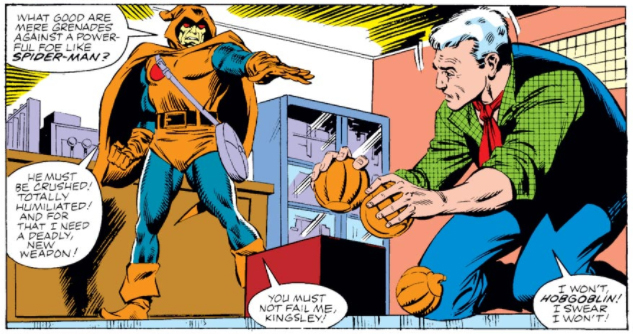 There's a LOT going on, also including a guest appearance by The Wasp, a Policeman With A Secret, and a big fight at an airport. It's all very nicely written and drawn, but dipping into so many stories without much explanation and with no resolutions at all feels rather alienating. Jim Shooter was very keen on the idea that every comic was somebody's first comic, and should be written with that in mind, and though this is very much not my first comic it does feel as if the only way to get anything out of it would be to read the entire run of the series for a couple of years either side, and there's nothing interesting or exciting enough to make me want to do so.
There's a LOT going on, also including a guest appearance by The Wasp, a Policeman With A Secret, and a big fight at an airport. It's all very nicely written and drawn, but dipping into so many stories without much explanation and with no resolutions at all feels rather alienating. Jim Shooter was very keen on the idea that every comic was somebody's first comic, and should be written with that in mind, and though this is very much not my first comic it does feel as if the only way to get anything out of it would be to read the entire run of the series for a couple of years either side, and there's nothing interesting or exciting enough to make me want to do so.
To put it another way: this comics feels like another harbinger of 90's Comics!
Doom's appearance comes in the obligatory Secret Wars recap, this time focussing entirely on Titania's origin.
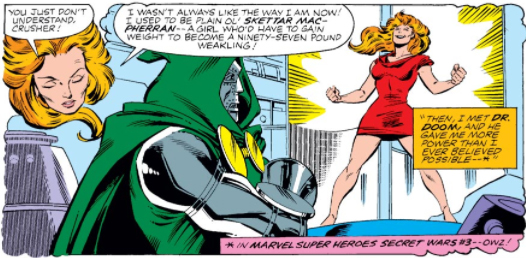 It's interesting that this is all done in a single panel, with a note just pointing out that it happened in Secret Wars, as if that's all the information that's needed to explain what's going on. There's an expectation that anybody reading this will know what Secret Wars was, and so no further explanation is necessary. I guess that was probably true, and to be honest I didn't notice this assumption at all the first time I read it. I'm not always onboard with the idea that you HAVE to explain every single thing in a story, as sometimes it's exciting to be thrown into a fully functioning fictional world and have to work out what's going on for yourself, but here it feels more like a lack of concern for anybody who's not already on board. As I say: here come the 90s!
It's interesting that this is all done in a single panel, with a note just pointing out that it happened in Secret Wars, as if that's all the information that's needed to explain what's going on. There's an expectation that anybody reading this will know what Secret Wars was, and so no further explanation is necessary. I guess that was probably true, and to be honest I didn't notice this assumption at all the first time I read it. I'm not always onboard with the idea that you HAVE to explain every single thing in a story, as sometimes it's exciting to be thrown into a fully functioning fictional world and have to work out what's going on for yourself, but here it feels more like a lack of concern for anybody who's not already on board. As I say: here come the 90s!
That's the lot for Doom this time, but stand by for more Doom in a single text than I think we've ever had before, as next time we finally get to "Emperor Doom"!
posted 25/6/2021 by MJ Hibbett
(click here for permanent link)
(0) comments
The Lady And The Unicorn
I've spent a lot of the past four years banging on about 'The Marvel Age' as a distinct period in superhero comics, and have gone so far as to Empirically Define it as being all American superhero comics with cover-dates from November 1961 (the first issue of Fantastic Four) to October 1987 (the last month with Jim Shooter credited as editor on all Marvel comics). If you ever see me out and about in The Real World I will be more than happy to bang on about it in person as well, or you can see me talking about it next month at Factually Accurate Stand-Up, but the basic idea is that this covers the time period in which Marvel emerged as first the creative leader in superhero comics, then the market leader, and then finally lost that creative lead under Jim Shooter.
One question that has arisen from this is 'So what comes next?' My standard answer is 'Not my problem', but if I was forced to answer I would probably suggest something similar to what people call 'The Dark Ages', when Marvel went bust, gimmicks were everywhere, and big name artists like Rob Liefeld came to the fore.
We get a little hint of this future in today's comic, mainly due to the artwork by Art Adams. I don't think he's usually roped in with people like Liefeld and Jim Lee, but his hugely detailed, super-stylised work, especially when drawing women, comes as a bit of a shock after reading a quarter century of Kirby-inspired superheroics.
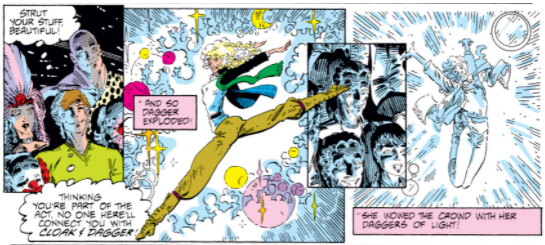 I must admit that I dropped out of superhero comics around this time, mostly because I was a student and couldn't afford to buy them anymore, but whenever I popped into a comic shop during my time of absence I can't say I was hugely impressed by what I saw. Looking back now, I can appreciate this style of art as something exciting and dynamic, even though I don't really like it myself, but what I can't get over is how turgid the writing would become. This issue's written by the great Bill Mantlo, for example, but the pages are packed with heavily Claremont-inspired dialogue that's drenched in metaphors and high emotions that, for me at least, is really difficult to read. Again, I know other people like it, but this style of prose has made some of the recent comics (especially "Beauty And The Beast"!) hard to get through!
I must admit that I dropped out of superhero comics around this time, mostly because I was a student and couldn't afford to buy them anymore, but whenever I popped into a comic shop during my time of absence I can't say I was hugely impressed by what I saw. Looking back now, I can appreciate this style of art as something exciting and dynamic, even though I don't really like it myself, but what I can't get over is how turgid the writing would become. This issue's written by the great Bill Mantlo, for example, but the pages are packed with heavily Claremont-inspired dialogue that's drenched in metaphors and high emotions that, for me at least, is really difficult to read. Again, I know other people like it, but this style of prose has made some of the recent comics (especially "Beauty And The Beast"!) hard to get through!
The actual storyline, as far as I can make out, sees Dagger wanting to join the circus but Cloak thinking she's wasting her talents. There's also a smarmy boyfriend and Cloak is... maybe evil?
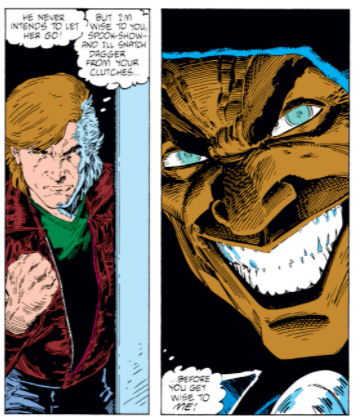 The story includes that really annoying thing where superheroes, who live in a superhero world where weird things happen all the time and there is literally a person called Nightmare who controls dreams and a version of Satan who steals souls, just shrug off Terrible Feelings and Dire Omens as "just a bad dream". Come on guys, this is your ninth issue, get with it!
The story includes that really annoying thing where superheroes, who live in a superhero world where weird things happen all the time and there is literally a person called Nightmare who controls dreams and a version of Satan who steals souls, just shrug off Terrible Feelings and Dire Omens as "just a bad dream". Come on guys, this is your ninth issue, get with it!
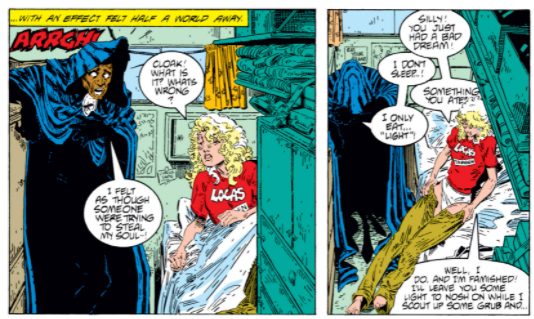 Also, Dagger seems to have forgotten that Cloak doesn't eat, which seems a bit insensitive. Anyway, some mobsters turn up and there's a big gunfight, so the circus fights back in an appropriately circus-like way, with strong-men and human cannonballs.
Also, Dagger seems to have forgotten that Cloak doesn't eat, which seems a bit insensitive. Anyway, some mobsters turn up and there's a big gunfight, so the circus fights back in an appropriately circus-like way, with strong-men and human cannonballs.
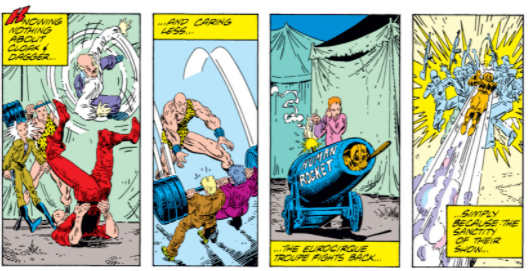 The post-Marvel Age period was known for its "Grim 'n' Gritty" nature, and that is very much on display here when the gunfight between mobsters, clowns various and an elephant ends, as it so often does, with the accidental death of a unicorn.
The post-Marvel Age period was known for its "Grim 'n' Gritty" nature, and that is very much on display here when the gunfight between mobsters, clowns various and an elephant ends, as it so often does, with the accidental death of a unicorn.
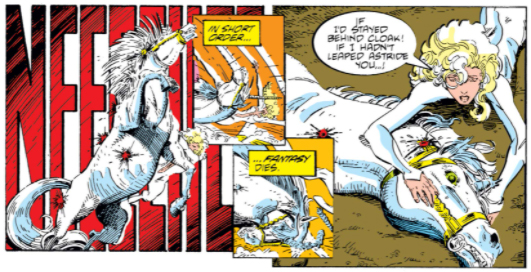 Heavy stuff! Dagger zaps the unicorn-murderers and then she, Cloak and the smarmy boyfriend teleport away to continue on their neverending quest to do whatever it was they were meant to be doing all along. And that's the lot, except for one last panel which - finally! - tells us why this comic is in a blog about Doctor Doom.
Heavy stuff! Dagger zaps the unicorn-murderers and then she, Cloak and the smarmy boyfriend teleport away to continue on their neverending quest to do whatever it was they were meant to be doing all along. And that's the lot, except for one last panel which - finally! - tells us why this comic is in a blog about Doctor Doom.
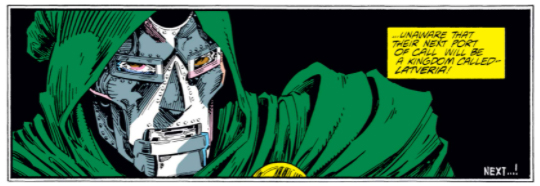 As Douglas Wolk recently pointed out in an episode of his (excellent) Voice Of Latveria podcast, Doom popping up right at the very end of a comic is something that happens an awful lot. Sometimes he's used as a big final twist, like in Strange Tales #167 and Fantastic Four #196, while other times, such as here and in Champions #15 he's used as an enticement to come back next time. It's certainly worked here, as we'll be back in a couple of weeks to see what happens when Doom meets Cloak and Dagger, but before then we're off to see yet another Secret Wars flashback with Spider-man!
As Douglas Wolk recently pointed out in an episode of his (excellent) Voice Of Latveria podcast, Doom popping up right at the very end of a comic is something that happens an awful lot. Sometimes he's used as a big final twist, like in Strange Tales #167 and Fantastic Four #196, while other times, such as here and in Champions #15 he's used as an enticement to come back next time. It's certainly worked here, as we'll be back in a couple of weeks to see what happens when Doom meets Cloak and Dagger, but before then we're off to see yet another Secret Wars flashback with Spider-man!
(click here for permanent link)
(0) comments
The Once And Future Kang!
Recently we've seen several examples of John Byrne claiming ownership of Doctor Doom by dragging together various previous appearances into a single storyline under his authorship. In this issue we see Roger Stern do much the same for Kang The Conqueror!
There's an awful lot of recapping in this comic, and that's where we find Doctor Doom, in a re-telling of his first meeting with Rama Tut way back in Fantastic Four Annual #2. John Buscema re-draws a panel from that issue from a different angle, this time showing Doom's rescue from space from his own perspective.
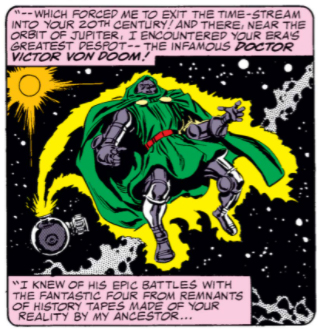
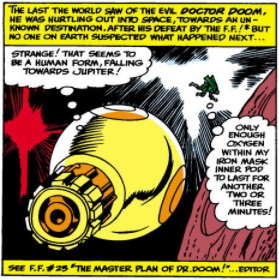 My favourite aspect of this page is that Roger Stern has Rama Tut saying that this meeting happened when "I had just finished removing my ceremonial beard." Stern is so concerned with tidying up the continuity that he takes time out to explicitly explain why Rama Tut looked slightly different in his second appearance from his first.
My favourite aspect of this page is that Roger Stern has Rama Tut saying that this meeting happened when "I had just finished removing my ceremonial beard." Stern is so concerned with tidying up the continuity that he takes time out to explicitly explain why Rama Tut looked slightly different in his second appearance from his first.
That's all for Doom in this issue - he doesn't even get any dialogue! After that there are pages and pages of further recapping, which I take to be mostly re-tellings of previous stories - I can't say for sure because I've only read every Doctor Doom story up to this point, not every Kang story. There are a few story quotations that I do recognise though, and John Buscema uses rounded panel borders to indicate that these are historical re-tellings, so I assume most or all of the panels in this style are the same. For instance, he redraws a specific panel from Rama Tut's first appearance in Fantastic Four #19 in this way.
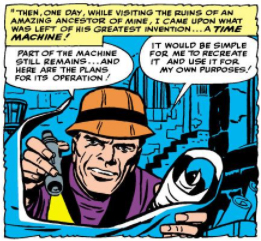
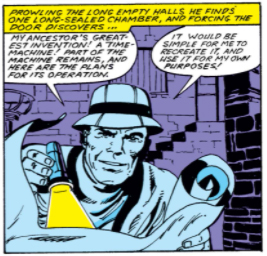
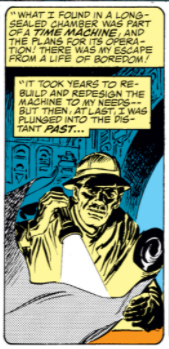 The middle picture above is the same panel redrawn three years earlier by John Byrne in Fantastic Four #273, where he slipped Rama Tut's origin into an alternate future where Reed Richard's father was The Warlord, a ruler who saved civilisation on Earth, and Buscema re-draws several panels from that too.
The middle picture above is the same panel redrawn three years earlier by John Byrne in Fantastic Four #273, where he slipped Rama Tut's origin into an alternate future where Reed Richard's father was The Warlord, a ruler who saved civilisation on Earth, and Buscema re-draws several panels from that too.
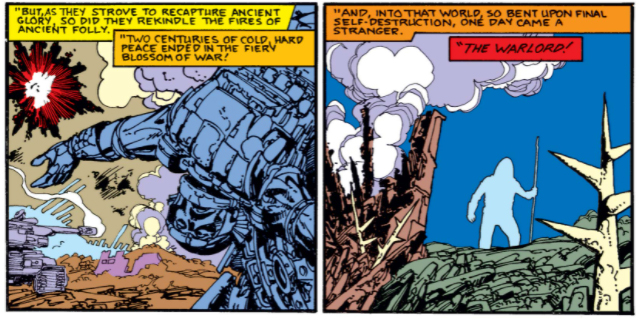

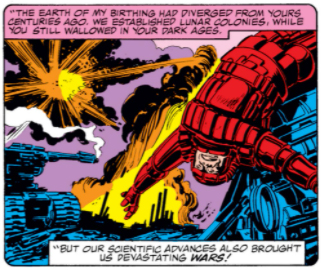 So this means that Rama Tut was distantly related to Reed Richards, and if you think that makes things complicated it is as nothing to the general shenanigans of the story itself. Kang The Conqueror has been zipping about through time accidentally creating new realities with divergent versions of himself in them, divergent versions which he has frankly no time for.
So this means that Rama Tut was distantly related to Reed Richards, and if you think that makes things complicated it is as nothing to the general shenanigans of the story itself. Kang The Conqueror has been zipping about through time accidentally creating new realities with divergent versions of himself in them, divergent versions which he has frankly no time for.
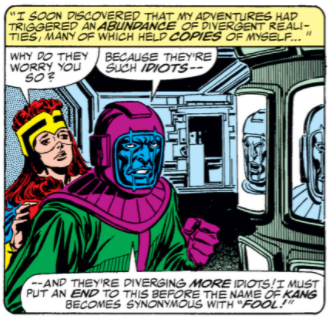 Who among us can honestly say they have never looked back at younger versions of ourselves and thought "They're such IDIOTS!" This version of Kang has managed to kill almost all of the other versions of himself except one, who is being held in a paralysis beam with The Avengers. The superheroes (who spend most of the issue literally standing around doing nothing) eventually manage to escape using the tried and tested superhero methodologies of Trying Really Hard and also Never Giving Up, which allows the other Kang to get away too. A big fight breaks out and Kang Senior kills Kang Junior, at which point Immortus turns up!
Who among us can honestly say they have never looked back at younger versions of ourselves and thought "They're such IDIOTS!" This version of Kang has managed to kill almost all of the other versions of himself except one, who is being held in a paralysis beam with The Avengers. The superheroes (who spend most of the issue literally standing around doing nothing) eventually manage to escape using the tried and tested superhero methodologies of Trying Really Hard and also Never Giving Up, which allows the other Kang to get away too. A big fight breaks out and Kang Senior kills Kang Junior, at which point Immortus turns up!
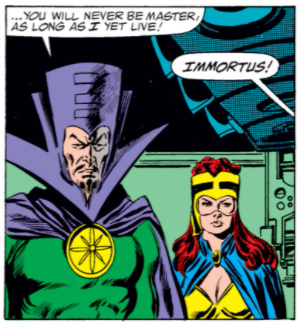 Immortus is yet another version of Kang from the far future, who Kang's girlfriend Ravonna has secretly been working with all along because he's the good version of him, whereas all the others are idiots for whom Immortus also has very little time.
Immortus is yet another version of Kang from the far future, who Kang's girlfriend Ravonna has secretly been working with all along because he's the good version of him, whereas all the others are idiots for whom Immortus also has very little time.
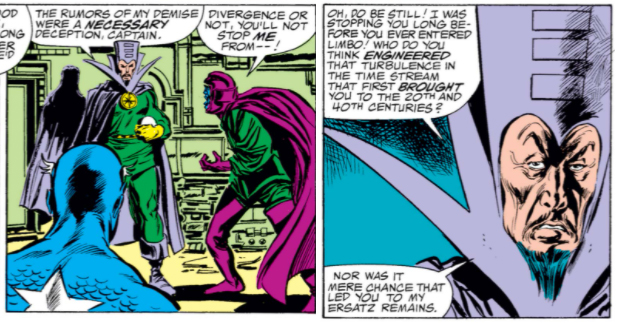 I love that bit of dialogue - "Oh do be still!"
I love that bit of dialogue - "Oh do be still!"
So, just to be clear, Reed Richard's Dad went sideways in time to an alternate Earth which he saved from devastation. Centuries later his ancestor, inspired by The Fantastic Four, went back to Egyptian times to become Rama Tut. When he was defeated he then went forward in time where he met, and rescued Doctor Doom - thankfully Roger Stern explicitly says that Rama Tut was fibbing when he said he and Doom might be the same person, which is some relief at least. Rama Tut, now inspired by Doctor Doom, built himself a suit of armour, and went back and forth in time creating loads of idiotic versions of himself which he felt duty bound to kill, only to get told off and then tricked into Limbo by Immortus, yet another version of himself from the far future who's decided to stop being an idiot and instead be a bit of a dick instead.
With a story as straightforward and sensible as this, you can see why Marvel Studios are so keen to have Kang as the next big villain! Joking aside, it's all written in a thoroughly entertaining way, much like Byrne's excercises in continuity-grabbing, and it looks great thanks to John Buscema. It does feel a little weird to see an absolute legend of superhero comics re-drawing panels by creators who would have grown up reading his stuff, but it's all lovely to look at, with Tom Palmer's inks keeping it recognisably Buscema with a "modern" (for the late 80s) sheen to it.
The only thing this story is lacking is more Doctor Doom, but there's plenty of him to come soon!
posted 11/6/2021 by MJ Hibbett
(click here for permanent link)
(0) comments
The Marvel Superheroes Role-Playing Game
Today we're looking at one of Doom's adventures into non-comics media, and it's an area I know very little about - role-playing games! When he's appeared in cartoons, or radio shows or computer games I've had at least some experience of how those all work, but I have had precisely one direct experience of role-playing games, and it wasn't a very good one.
It was a rainy lunch-time in my second year of senior school (so I would have been about 12) and someone had brought in a copy of Dungeons And Dragons. My memories of it consist of a lengthy, very complicated, explanation of the rules, approximately two throws of the dice, a lot more explanation of what we'd done wrong, and then we were all dead. It was all incredibly pernickety and annoying, and I think that all of us gathered around that school desk were put off it for life.
Since then I've known several people who love these games, and tell me it's a free-flowing communal improvisation, expressing imagination wherever it takes you, and I'm sure it is, but I must say that reading through some of the material today takes me right back to that lunchtime.
There are five items all together in this look at TSR's "Marvel Superheroes Secret Wars Special Campaign Adventure" - three hefty tomes of rules and two sets of figures. The figures are pretty easy for me to get my head around. The first is a set of miniature figureines showing the heroes and villains in action, while the second is a similar, presumably much-cheaper, set of cardboard cut-out versions. This is an adaptation of "Secret Wars", so of course Doctor Doom is featured in both.
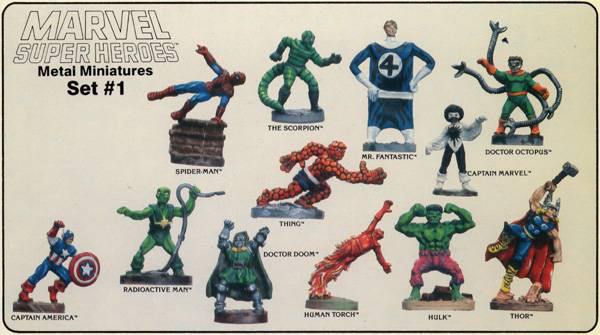
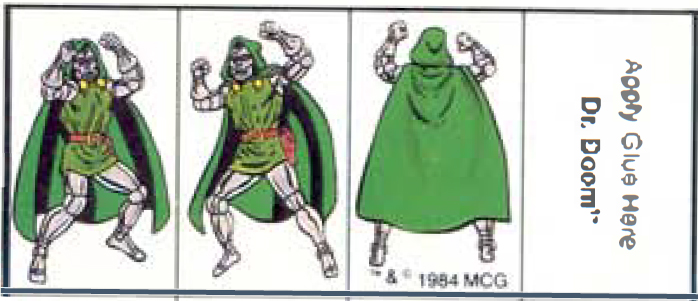 In both cases Doom has his arms raised in anger, with all his usual character signifiers in place, although for some reason his gun holster is on his left hip rather than his usual right on the cut-out version. Whichever of these figures are used, they're all meant to go onto a map somehow, which is then used to plot the characters' progress through the game.
In both cases Doom has his arms raised in anger, with all his usual character signifiers in place, although for some reason his gun holster is on his left hip rather than his usual right on the cut-out version. Whichever of these figures are used, they're all meant to go onto a map somehow, which is then used to plot the characters' progress through the game.
It's at this point that I get a bit lost, as the actual game instructions are bewilderingly complicated. It sounds very interesting to begin with, offering the players the chance to create their own stories - "You can branch out on your own. Not all the tales of the SECRET WARS have been told," it days. However, there are then sixteen closely typed pages of RULES telling you exactly what you can and cannot do, in a game divided into days with each day divided into four "shifts", which makes it sound like work rather than fun. There's a map of Battleworld itself, then rules on how you move around, how buildings work, how events occur and how characters can act. I know it's called a "rulebook" but this seems like a lot of rules!
Interestingly, for me at least, the various areas covered do align quite well with the work I'm doing on my PhD. My categorisation divides character aspects into character-based (what they look like, how they talk etc), storyworld-based (the settings, rules, history and so on), behavioural (how the characters interact with each other within the storyworld) and authorial (who creates them). There's nothing much about authorship in this book, but there's a LOT about everything else.
This continues when we get into the "Roster Booklet" section, where each character gets described in terms of the games statistics. For characters these include ratings for fighting, agility, strength, endurance, reason, intuition and psyche, then scores for health, karma, resources and popularity. The ratings have a scale with names like "excellent", "remarkable", "typical", "good", "unearthly" and "amazing" which, as far as I can see, aren't actually put in order anywhere. Is being excellent better than being amazing? Where does being unearthly come into it? It feels very much like the authors wanted to make sure there'd be as many chances for bickering as possible!
Doom's listing is pretty accurate, and includes a neat summation of his origin which even has space to address the knotty problem of him apparently being dead before Secret Wars began!
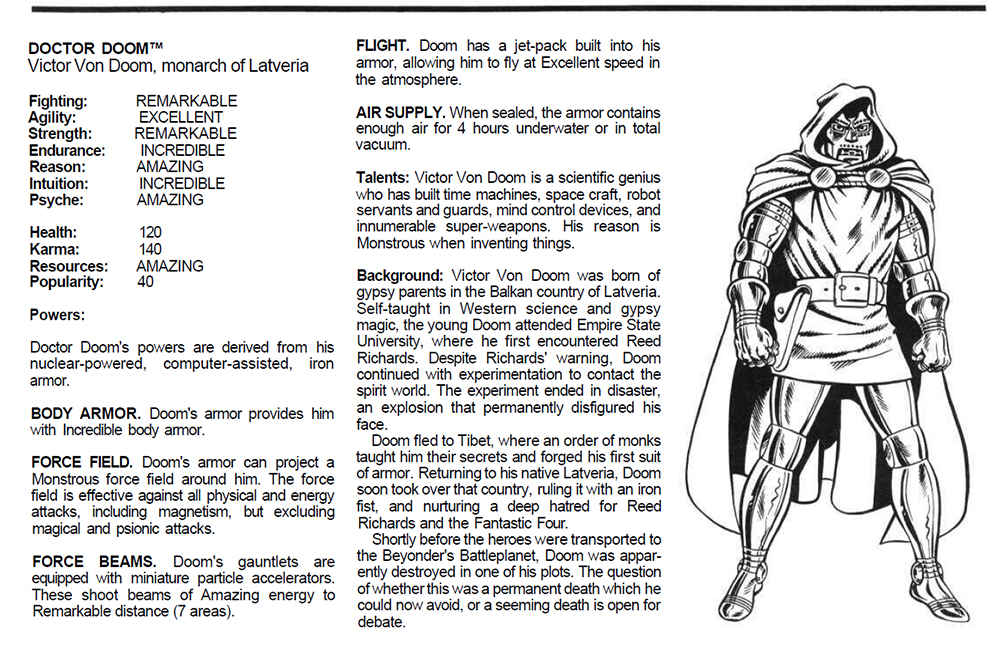 As somebody who's spent several years categorising Doom, there's not really much to disagree with here. Even the relatively high score of 40 for "popularity" seems fair enough, as he does know a lot of people!
As somebody who's spent several years categorising Doom, there's not really much to disagree with here. Even the relatively high score of 40 for "popularity" seems fair enough, as he does know a lot of people!
This is explained in the next book, called the "Player's Book", as due to him being a "charismatic bad guy... whose very evil bends others to their will", which sounds about right. This book is 100 pages long and is packed with rules about everything you can imagine, and again feels like a device for encouraging bickering. I can imagine it being very handy if you were setting up a computer game, and using it as a way to develop the rules that ran it, but it does seem like an awful lot of work to have to go through before you can even start playing. As I say, I've spent five years on the PhD trying to understand how this sort of thing works, and even I think it's a bit much!
Most of the illustrations for these books are taken from the comics - even the front and back covers of the main rulebook are adapted from the covers of Secret Wars #1 and #6 - but the front of the "Player's Book" and final "Judge's Book" do at least have original art, with the judge's book featuring the villains.
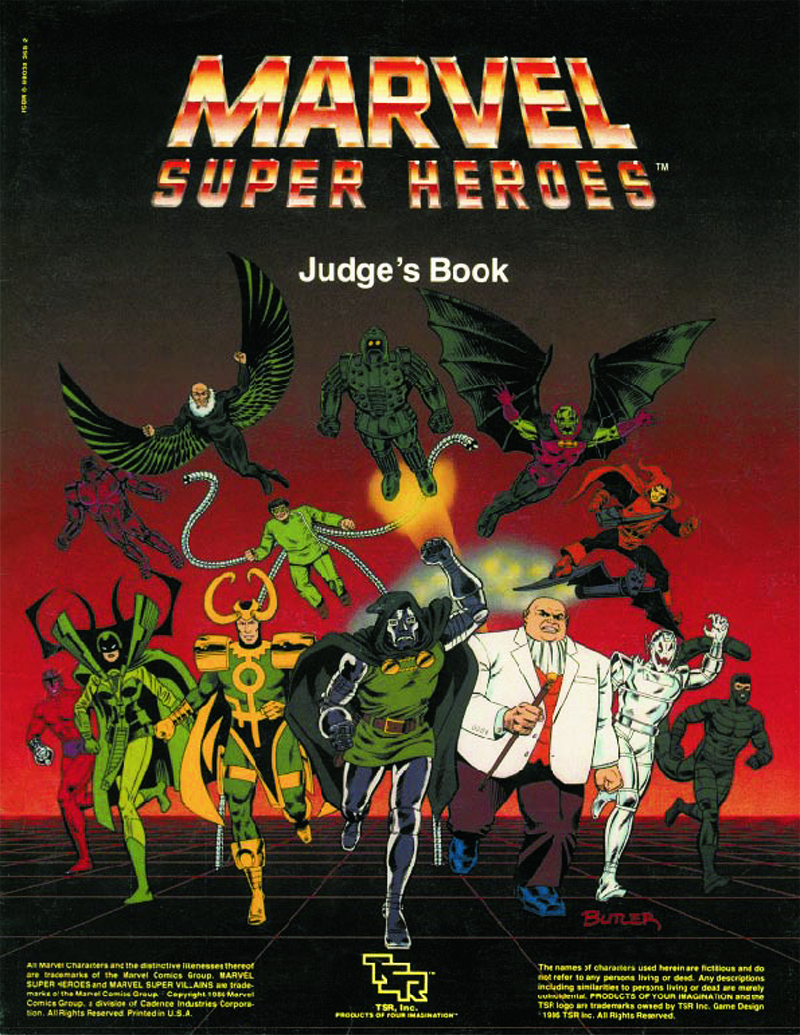 It's nice to see that they've put Doom in his proper place, front and centre leading all the others forward! This is another massive tome, although this one does at least recognise the fact with a sentence right at the start that says "Don’t let the size of this product, the amount of text included, put you off." It goes on to say that this, along with the Player's Book mentioned above, is an expansion of the original game, encouraging judges and players to invent new stories using the game machinery described. Within this book there's new rules about things like other dimensions and creating new settings, and the general gist seems to be more towards fans exercising their own imaginations to generate more stories, although it's all in the context of loads and loads of facts and figures and rules. As I say, if this was all in a computer game then I guess all of that would be invisible, allowing players to feel like they were in a "sandbox" where they could do what they like. Maybe it's just that seeing the mechanics laid out like this makes it feel more... well, mechanical.
It's nice to see that they've put Doom in his proper place, front and centre leading all the others forward! This is another massive tome, although this one does at least recognise the fact with a sentence right at the start that says "Don’t let the size of this product, the amount of text included, put you off." It goes on to say that this, along with the Player's Book mentioned above, is an expansion of the original game, encouraging judges and players to invent new stories using the game machinery described. Within this book there's new rules about things like other dimensions and creating new settings, and the general gist seems to be more towards fans exercising their own imaginations to generate more stories, although it's all in the context of loads and loads of facts and figures and rules. As I say, if this was all in a computer game then I guess all of that would be invisible, allowing players to feel like they were in a "sandbox" where they could do what they like. Maybe it's just that seeing the mechanics laid out like this makes it feel more... well, mechanical.
Doom appears in the "Villains" section, which has a much clearer version of character attributes - the categories are still the same, but this time they get numerical scores and, in line with the idea of "negative popularity" his score there has changed from 40 to -40! He gets two columns of text, as opposed to the usual single column for other villains, which includes information about how his Doombots work, and another version of the origin, which is worth putting here in full:
Victor von Doom is a self-taught tyrant, who rose from humble beginnings as the son of gypsies to his present status as an international madman. Doom is a technological genius, and is continually modifying his armor with new inventions and devices. He is a man of honor and his word, and specializes in schemes to destroy his enemies. He has three goals in life: to rule the entire world; to destroy his rival Reed Richards; and to rescue the spirit of his mother, which is trapped in a netherworld dimension. He is not someone to offend, as he will take the time and effort to hunt down and destroy his enemies.
I love the idea of "international madman" being something to aim for. I imagine you'd start as just a local madman, compete to national level, and then move onto the world stage.
More seriously, I find the description of his three motivations very interesting. In my research I've found that, during this period, the desire to save his mother only comes up a couple of times, and the need to thwart Reed Richards only really crops up when he's in a Fantastic Four comic. In other series, and especially in other media, Doom rarely if ever mentions him, which was a surprise as this is often given, as here, as one of his main motivations. Even ruling the world isn't quite as big a motivation as it's often said to be. Instead, according to my research anyway, what drives Doom is the need to prove himself to be better than other people. That's pretty much it, which I guess does cover ruling the world and beating Reed Richards, but is far and away the most common thing that drives him.
Towards the end of the guide there are brief descriptions of what we would these days call "Non-Player Characters". Being comics, this includes a huge variety of creatures, from fish and horses to "Dinosaur, Giant Armored" and "Dinosaur, Giant Radioactive", and from Asgardians and Denizens Of The Dark Dimension to Paramedics and Lawyers. Truly, all human (and non-human) life is here!
In summary then, these rulebooks and figures are similar in some ways to the overriding research project behind this blog, which is trying to find ways to describe how transmedia characters work. They're surprisingly similar in places too, although I'd like to think that my eventual schema will lead to less bickering... although, on the other hand, maybe it won't!
posted 4/6/2021 by MJ Hibbett
(click here for permanent link)
(0) comments